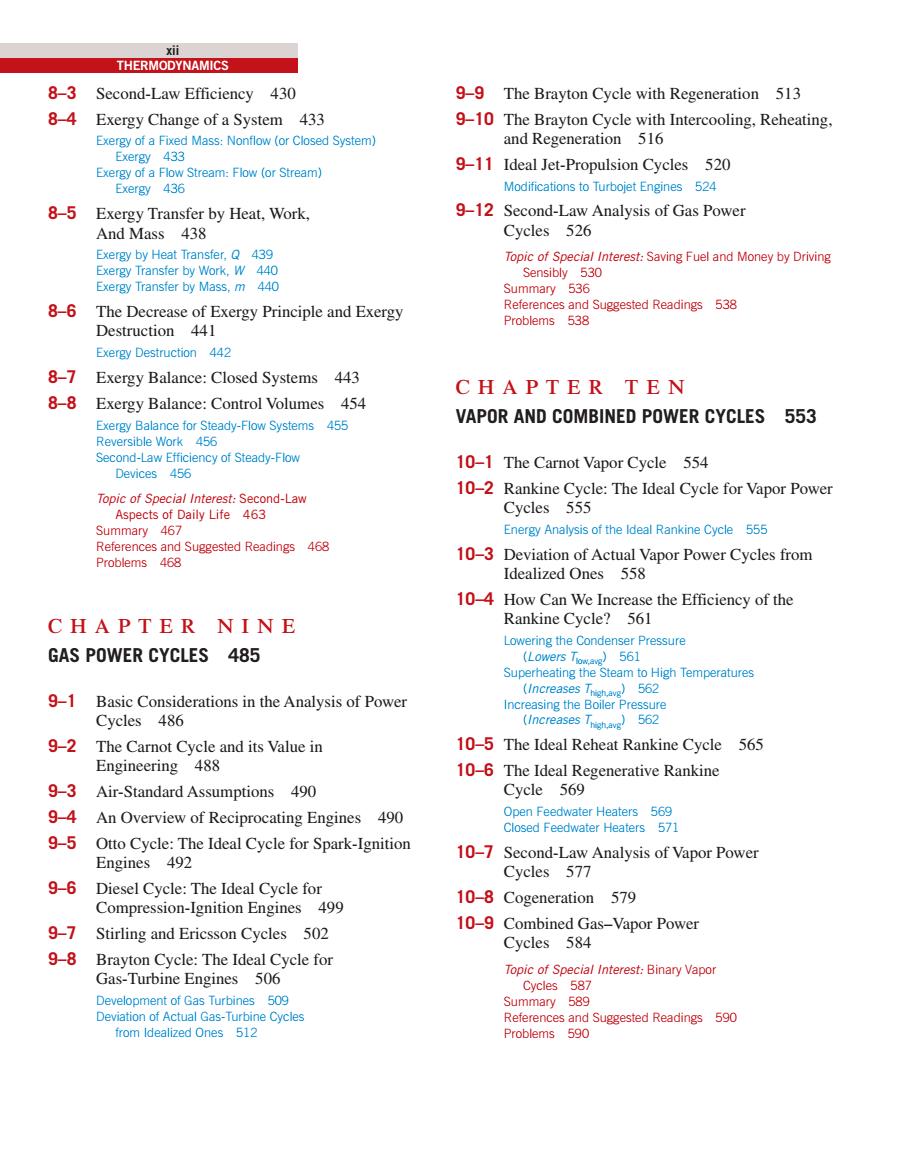正在加载图片...

xii THERMODYNAMICS 8-3 Second-Law Efficiency 430 9-9 The Brayton Cycle with Regeneration 513 8-4 Exergy Change of a System 433 9-10 The Brayton Cycle with Intercooling,Reheating, Exergy of a Fixed Mass:Nonflow (or Closed System) and Regeneration 516 Exergy 433 Exergy of a Flow Stream:Flow (or Stream) 9-11 Ideal Jet-Propulsion Cycles 520 Exergy 436 Modifications to Turbojet Engines 524 8-5 Exergy Transfer by Heat,Work, 9-12 Second-Law Analysis of Gas Power And Mass 438 Cycles 526 Exergy by Heat Transfer,Q 439 Topic of Special Interest:Saving Fuel and Money by Driving Exergy Transfer by Work,W 440 Sensibly 530 Exergy Transfer by Mass,m 440 Summary 536 8-6 The Decrease of Exergy Principle and Exergy References and Suggested Readings 538 Problems 538 Destruction 441 Exergy Destruction 442 8-7 Exergy Balance:Closed Systems 443 CHAPTER TEN 8-8 Exergy Balance:Control Volumes 454 Exergy Balance for Steady-Flow Systems 455 VAPOR AND COMBINED POWER CYCLES 553 Reversible Work 456 Second-Law Efficiency of Steady-Flow 10-1 The Carnot Vapor Cycle 554 Devices 456 Topic of Special Interest:Second-Law 10-2 Rankine Cycle:The Ideal Cycle for Vapor Power Aspects of Daily Life 463 Cycles 555 Summary 467 Energy Analysis of the ldeal Rankine Cycle 555 References and Suggested Readings 468 Problems 468 10-3 Deviation of Actual Vapor Power Cycles from Idealized Ones 558 10-4 How Can We Increase the Efficiency of the CHAPTER NINE Rankine Cycle?561 Lowering the Condenser Pressure GAS POWER CYCLES 485 (Lowers T)561 Superheating the Steam to High Temperatures (Increases Thighave)562 9-1 Basic Considerations in the Analysis of Power Increasing the Boiler Pressure Cycles 486 (Increases Thghave)562 9-2 The Carnot Cycle and its Value in 10-5 The Ideal Reheat Rankine Cycle 565 Engineering 488 10-6 The Ideal Regenerative Rankine 9-3 Air-Standard Assumptions 490 Cycle 569 9-4 An Overview of Reciprocating Engines 490 Open Feedwater Heaters 569 Closed Feedwater Heaters 571 9-5 Otto Cycle:The Ideal Cycle for Spark-Ignition Engines 492 10-7 Second-Law Analysis of Vapor Power Cycles 577 9-6 Diesel Cycle:The Ideal Cycle for Compression-Ignition Engines 499 10-8 Cogeneration 579 9-7 Stirling and Ericsson Cycles 502 10-9 Combined Gas-Vapor Power Cycles 584 9-8 Brayton Cycle:The Ideal Cycle for Topic of Special Interest:Binary Vapor Gas-Turbine Engines 506 Cycles 587 Development of Gas Turbines 509 Summary 589 Deviation of Actual Gas-Turbine Cycles References and Suggested Readings 590 from Idealized Ones 512 Problems 590xii THERMODYNAMICS 8–3 Second-Law Efficiency 430 8–4 Exergy Change of a System 433 Exergy of a Fixed Mass: Nonflow (or Closed System) Exergy 433 Exergy of a Flow Stream: Flow (or Stream) Exergy 436 8–5 Exergy Transfer by Heat, Work, And Mass 438 Exergy by Heat Transfer, Q 439 Exergy Transfer by Work, W 440 Exergy Transfer by Mass, m 440 8–6 The Decrease of Exergy Principle and Exergy Destruction 441 Exergy Destruction 442 8–7 Exergy Balance: Closed Systems 443 8–8 Exergy Balance: Control Volumes 454 Exergy Balance for Steady-Flow Systems 455 Reversible Work 456 Second-Law Efficiency of Steady-Flow Devices 456 Topic of Special Interest: Second-Law Aspects of Daily Life 463 Summary 467 References and Suggested Readings 468 Problems 468 chapter nine GAS POWER CYCLES 485 9–1 Basic Considerations in the Analysis of Power Cycles 486 9–2 The Carnot Cycle and its Value in Engineering 488 9–3 Air-Standard Assumptions 490 9–4 An Overview of Reciprocating Engines 490 9–5 Otto Cycle: The Ideal Cycle for Spark-Ignition Engines 492 9–6 Diesel Cycle: The Ideal Cycle for Compression-Ignition Engines 499 9–7 Stirling and Ericsson Cycles 502 9–8 Brayton Cycle: The Ideal Cycle for Gas-Turbine Engines 506 Development of Gas Turbines 509 Deviation of Actual Gas-Turbine Cycles from Idealized Ones 512 9–9 The Brayton Cycle with Regeneration 513 9–10 The Brayton Cycle with Intercooling, Reheating, and Regeneration 516 9–11 Ideal Jet-Propulsion Cycles 520 Modifications to Turbojet Engines 524 9–12 Second-Law Analysis of Gas Power Cycles 526 Topic of Special Interest: Saving Fuel and Money by Driving Sensibly 530 Summary 536 References and Suggested Readings 538 Problems 538 chapter ten VAPOR AND COMBINED POWER CYCLES 553 10–1 The Carnot Vapor Cycle 554 10–2 Rankine Cycle: The Ideal Cycle for Vapor Power Cycles 555 Energy Analysis of the Ideal Rankine Cycle 555 10–3 Deviation of Actual Vapor Power Cycles from Idealized Ones 558 10–4 How Can We Increase the Efficiency of the Rankine Cycle? 561 Lowering the Condenser Pressure (Lowers Tlow,avg) 561 Superheating the Steam to High Temperatures (Increases Thigh,avg) 562 Increasing the Boiler Pressure (Increases Thigh,avg) 562 10–5 The Ideal Reheat Rankine Cycle 565 10–6 The Ideal Regenerative Rankine Cycle 569 Open Feedwater Heaters 569 Closed Feedwater Heaters 571 10–7 Second-Law Analysis of Vapor Power Cycles 577 10–8 Cogeneration 579 10–9 Combined Gas–Vapor Power Cycles 584 Topic of Special Interest: Binary Vapor Cycles 587 Summary 589 References and Suggested Readings 590 Problems 590 cen98179_fm_i-xxvi.indd xii 11/29/13 6:39 PM